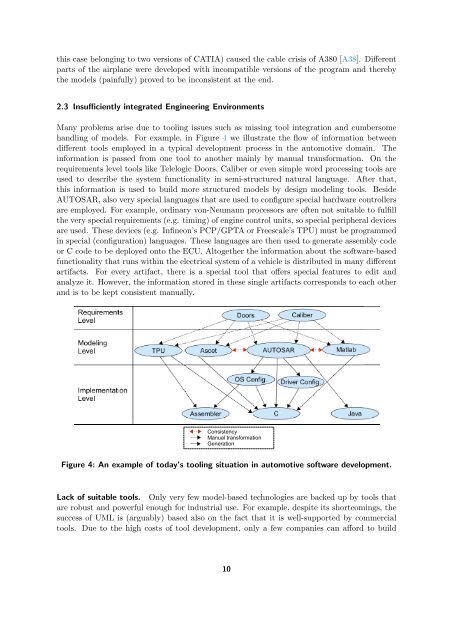SPES 2020 Deliverable 1.4.B-3 Concepts for an Integrated Tool ...
SPES 2020 Deliverable 1.4.B-3 Concepts for an Integrated Tool ...
SPES 2020 Deliverable 1.4.B-3 Concepts for an Integrated Tool ...
Create successful ePaper yourself
Turn your PDF publications into a flip-book with our unique Google optimized e-Paper software.
this case belonging to two versions of CATIA) caused the cable crisis of A380 [A38]. Different<br />
parts of the airpl<strong>an</strong>e were developed with incompatible versions of the program <strong>an</strong>d thereby<br />
the models (painfully) proved to be inconsistent at the end.<br />
2.3 Insufficiently integrated Engineering Environments<br />
M<strong>an</strong>y problems arise due to tooling issues such as missing tool integration <strong>an</strong>d cumbersome<br />
h<strong>an</strong>dling of models. For example, in Figure 4 we illustrate the flow of in<strong>for</strong>mation between<br />
different tools employed in a typical development process in the automotive domain. The<br />
in<strong>for</strong>mation is passed from one tool to <strong>an</strong>other mainly by m<strong>an</strong>ual tr<strong>an</strong>s<strong>for</strong>mation. On the<br />
requirements level tools like Telelogic Doors, Caliber or even simple word processing tools are<br />
used to describe the system functionality in semi-structured natural l<strong>an</strong>guage. After that,<br />
this in<strong>for</strong>mation is used to build more structured models by design modeling tools. Beside<br />
AUTOSAR, also very special l<strong>an</strong>guages that are used to configure special hardware controllers<br />
are employed. For example, ordinary von-Neum<strong>an</strong>n processors are often not suitable to fulfill<br />
the very special requirements (e.g. timing) of engine control units, so special peripheral devices<br />
are used. These devices (e.g. Infineon’s PCP/GPTA or Freescale’s TPU) must be programmed<br />
in special (configuration) l<strong>an</strong>guages. These l<strong>an</strong>guages are then used to generate assembly code<br />
or C code to be deployed onto the ECU. Altogether the in<strong>for</strong>mation about the software-based<br />
functionality that runs within the electrical system of a vehicle is distributed in m<strong>an</strong>y different<br />
artifacts. For every artifact, there is a special tool that offers special features to edit <strong>an</strong>d<br />
<strong>an</strong>alyze it. However, the in<strong>for</strong>mation stored in these single artifacts corresponds to each other<br />
<strong>an</strong>d is to be kept consistent m<strong>an</strong>ually.<br />
Consistency<br />
M<strong>an</strong>ual tr<strong>an</strong>s<strong>for</strong>mation<br />
Generation<br />
Figure 4: An example of today’s tooling situation in automotive software development.<br />
Lack of suitable tools. Only very few model-based technologies are backed up by tools that<br />
are robust <strong>an</strong>d powerful enough <strong>for</strong> industrial use. For example, despite its shortcomings, the<br />
success of UML is (arguably) based also on the fact that it is well-supported by commercial<br />
tools. Due to the high costs of tool development, only a few comp<strong>an</strong>ies c<strong>an</strong> af<strong>for</strong>d to build<br />
10
















